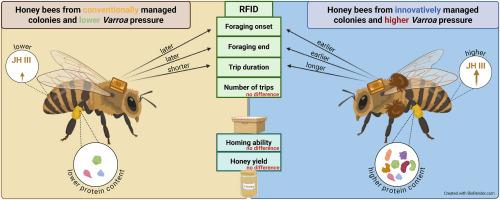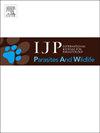平衡瓦螨管理和蜜蜂恢复力:暂时高螨压力的行为和生理后果
IF 2.2
3区 医学
Q3 ECOLOGY
International Journal for Parasitology-Parasites and Wildlife
Pub Date : 2025-09-13
DOI:10.1016/j.ijppaw.2025.101137
引用次数: 0
摘要
传粉媒介对全球农业和生态系统稳定至关重要,但由于寄生虫和病原体的影响,许多传粉媒介的数量正在下降。其中,除螨瓦螨(Varroa destructor)是对蜜蜂最严重的威胁之一。传统的治疗方法使用频繁的干预,以保持螨的水平尽可能低,而其他方法旨在促进自然选择通过省略治疗。一种可能的折衷办法是减少治疗,同时通过有针对性的干预维持蜂群的生存。这种方法可能允许在暂时螨虫压力下的适应性反应。在本研究中,我们比较了两种养蜂策略:1)传统养蜂方法,在交配季节定期清除雄蜂幼虫,夏季处理甲酸,冬季处理草酸。2)一种创新的方法,将雄蜂幼虫留在蜂群中,诱导其夏季产卵中断,然后进行草酸处理。只有在冬季治疗前不久,如果瓦螨压力每天超过三只自然掉落的螨虫,才适用冬季治疗。我们研究了瓦螨的侵害及其对蜜蜂觅食行为、归巢能力、幼蜂激素III水平、花粉蛋白含量和蜂蜜产量的影响。来自创新管理的蜂群的蜜蜂更早开始觅食,并且在年轻时就有较高的幼年激素水平。定向能力不受影响,但这些蜜蜂的觅食行程更长,采集的花粉蛋白质含量更高。它们也更早停止觅食,这可能反映了由于瓦罗亚压力增加而导致的寿命缩短。然而,两种养蜂方式之间的蜂群生产力没有差异。我们的研究结果表明,减少螨虫处理和暂时的高螨虫压力不会对群体性能产生负面影响。这种方法可能在集约化传统管理和基于选择的策略之间提供一个潜在的中间地带,平衡菌落活力和通过控制寄生虫和宿主暴露培养抗性性状的可能性。本文章由计算机程序翻译,如有差异,请以英文原文为准。

Balancing Varroa management and honey bee resilience: Behavioral and physiological consequences of temporarily high mite pressure
Pollinators are essential for global agriculture and ecosystem stability, yet many populations are declining due to parasites and pathogens. Among these, the ectoparasitic mite Varroa destructor is one of the most critical challenges to honey bees (Apis mellifera). Conventional treatment approaches use frequent interventions to keep mite levels as low as possible, whereas other approaches aim to promote natural selection by omitting treatments. A possible compromise lies in reducing treatments while maintaining colony survival through targeted interventions. This approach may allow adaptive responses under temporary mite pressure. In this study, we compared two beekeeping strategies: 1) Conventional beekeeping practice involving regular drone brood removal during mating season, formic acid treatment in summer, and oxalic acid treatment in winter. 2) An innovative approach where drone brood is left in the colony and a summer brood interruption is induced, followed by an oxalic acid treatment. Winter treatment is only applied if Varroa pressure exceeds three naturally dropped mites per day shortly before winter treatment. We investigated Varroa infestation and its consequences for honey bee foraging behavior, homing ability, juvenile hormone III levels, pollen protein content, and honey yield. Bees from innovatively managed colonies started foraging earlier and had elevated juvenile hormone levels at young ages. Orientation ability was unaffected, but these bees performed longer foraging trips and collected pollen with higher protein content. They also stopped foraging earlier, likely reflecting a reduced lifespan due to increased Varroa pressure. Nevertheless, colony productivity did not differ between the two beekeeping approaches. Our findings suggest that reduced Varroa treatments and temporarily high mite pressure do not have negative effects on colony performance. Such approaches may offer a potential middle ground between intensive conventional management and selection-based strategies, balancing colony vitality and the possibility of fostering resistance traits through controlled exposure of parasite and host.
求助全文
通过发布文献求助,成功后即可免费获取论文全文。
去求助
来源期刊

International Journal for Parasitology-Parasites and Wildlife
Medicine-Infectious Diseases
CiteScore
3.80
自引率
5.60%
发文量
113
审稿时长
45 days
期刊介绍:
The International Journal for Parasitology: Parasites and Wildlife (IJP-PAW) publishes the results of original research on parasites of all wildlife, invertebrate and vertebrate. This includes free-ranging, wild populations, as well as captive wildlife, semi-domesticated species (e.g. reindeer) and farmed populations of recently domesticated or wild-captured species (e.g. cultured fishes). Articles on all aspects of wildlife parasitology are welcomed including taxonomy, biodiversity and distribution, ecology and epidemiology, population biology and host-parasite relationships. The impact of parasites on the health and conservation of wildlife is seen as an important area covered by the journal especially the potential role of environmental factors, for example climate. Also important to the journal is ''one health'' and the nature of interactions between wildlife, people and domestic animals, including disease emergence and zoonoses.
 求助内容:
求助内容: 应助结果提醒方式:
应助结果提醒方式:


